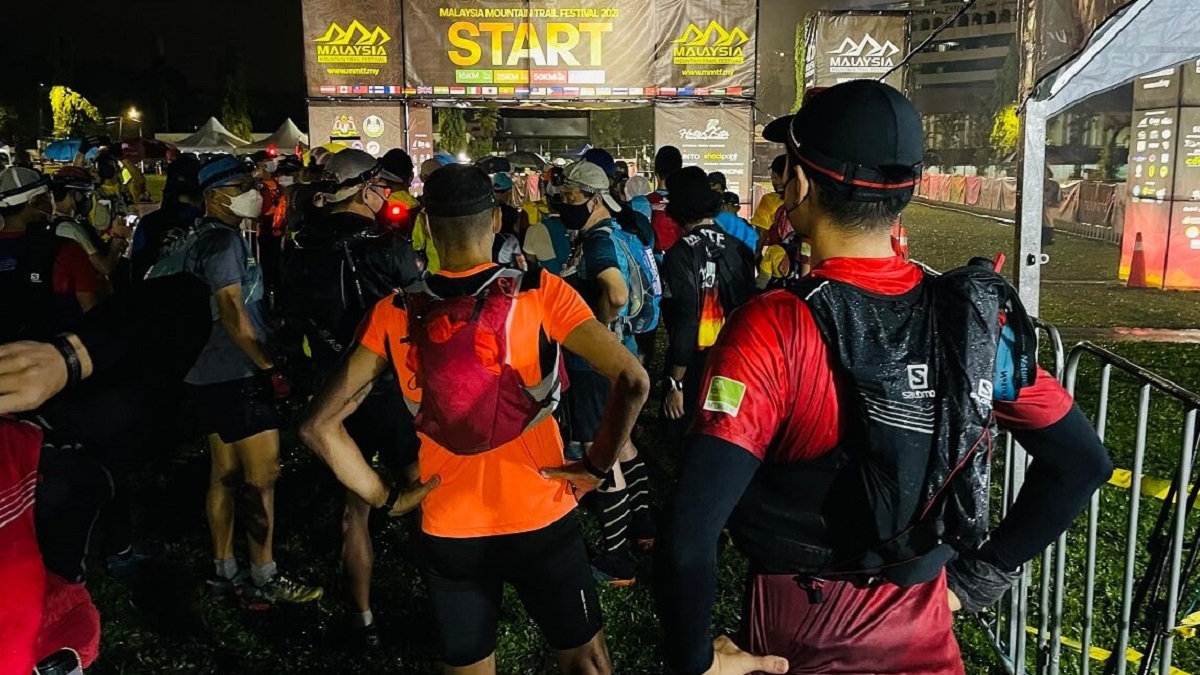It was just before 6 in the morning on 18 December 2021 when the gentle drizzle turned into a medium shower. The first-wave ultra-runners were all waiting at the starting pen, keeping a small distance between each other in compliance with the pandemic standard operating procedure. Personally for me, it took courage just to show up at the starting line.
For months I have been nervously anticipating the Malaysia Mountain Trail Festival 2021 (MMTF) race to happen. Despite the challenges of the pandemic and a new wave of Omicron variant spreading across the world, the organiser somehow managed to align all the pieces together. The race was set and all runners from various categories were assembled at Taiping Lake grounds on 18-19 December 2021.
Truth be told, I was secretly hoping that the race would be postponed because of Covid-19, again. I had rightly or foolishly signed up for the 84km category. With race route involving two big climbs up to the peak of Maxwell Hill twice, the 84km-MMTF has the notorious reputation of being a tough race with demanding total elevation gains.
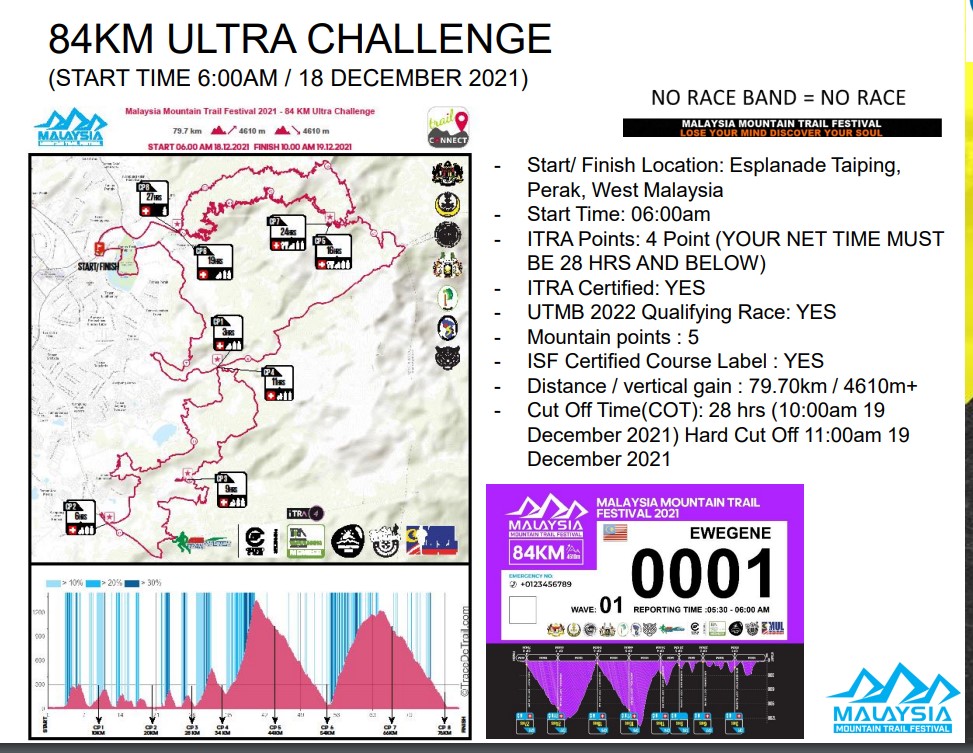
Maxwell Hill (also known as Bukit Larut) is a popular highland destination in Malaysia. It is located at an altitude of 1,250m above sea level approximately 10km from Taiping town in Perak. More critically for this race, it is also statistically known to be the wettest area in the country which experiences the highest rainfall.
It is well known and understood that if rain becomes an additional element during the weekend, the race would be tough and brutal. It was a big disaster for runners in the 2018 edition MMTF. Rain wrecked the trails and less than half of the participants crossed the finish line within the allowable time.
In my progression towards the 100km trail ultras, the odd 84km category is actually a perfect step-up distance. The longest distance I have participated was a relatively flat 70km trail passing through beautiful network of caves at the sleepy town of Merapoh, Pahang more than 2 years ago. The common race categories for trail ultras are either 50km or 100km. A double-up jump in distance may be too drastic of an upgrade for mortal runners.
The organiser did a fantastic job getting all the necessary approvals from countless departments and agencies, and went on to plot and mark the trails for 84km, 50km, 25km and 16km distance categories. Participants were provided with ample race information and kept informed on the race status leading to the event. Having said that, it is not my purpose to review the race here.
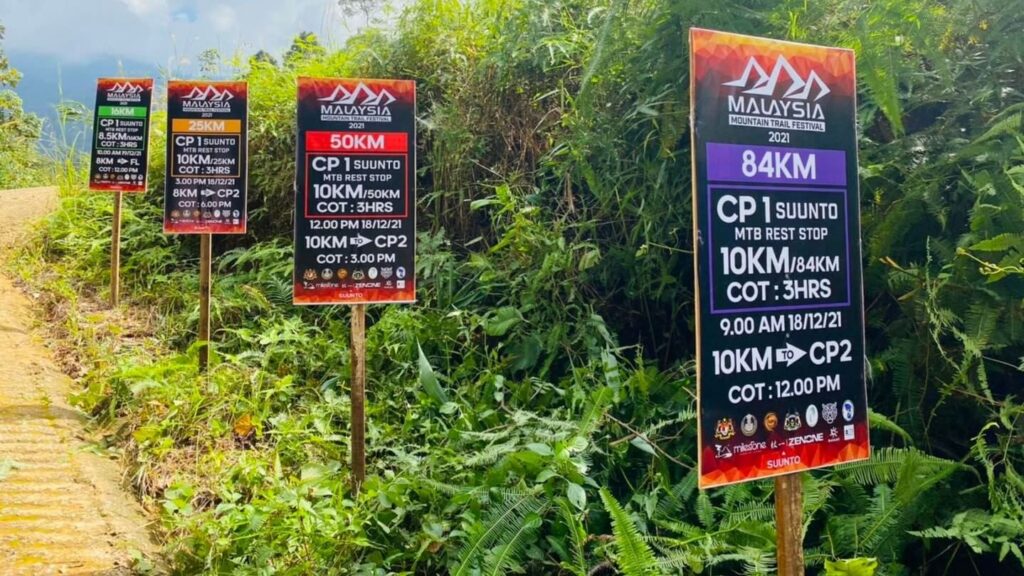
At exactly 6am, while it was still dark, the countdown ended and off we went starting our 84km ultra trail journey in the rain. Quietly, we understood and accepted that the trails ahead would be wet, muddy and slippery. It had drizzled to no end the day before and it did not look like the rain was about to stop.
We were given a gentle start for the first 3.5km running through the streets and paths around the Taiping Lake garden. But it wasn’t long before we hit the trails and the climbs started. The course was already demanding and with the near washout condition, the trail lived up to its reputation of being one of the toughest in Malaysia.
The climbs on muddy slopes were punishing. Downhill on slippery declines were equally as bad. The trail condition declined progressively and slope steps disappeared as more runners thrashed them. I slipped and fell a few times and the experience was humbling. I wasn’t moving well and my average pace suffered. This was something that I knew would happen if it rains yet I don’t get much chance to train for it.
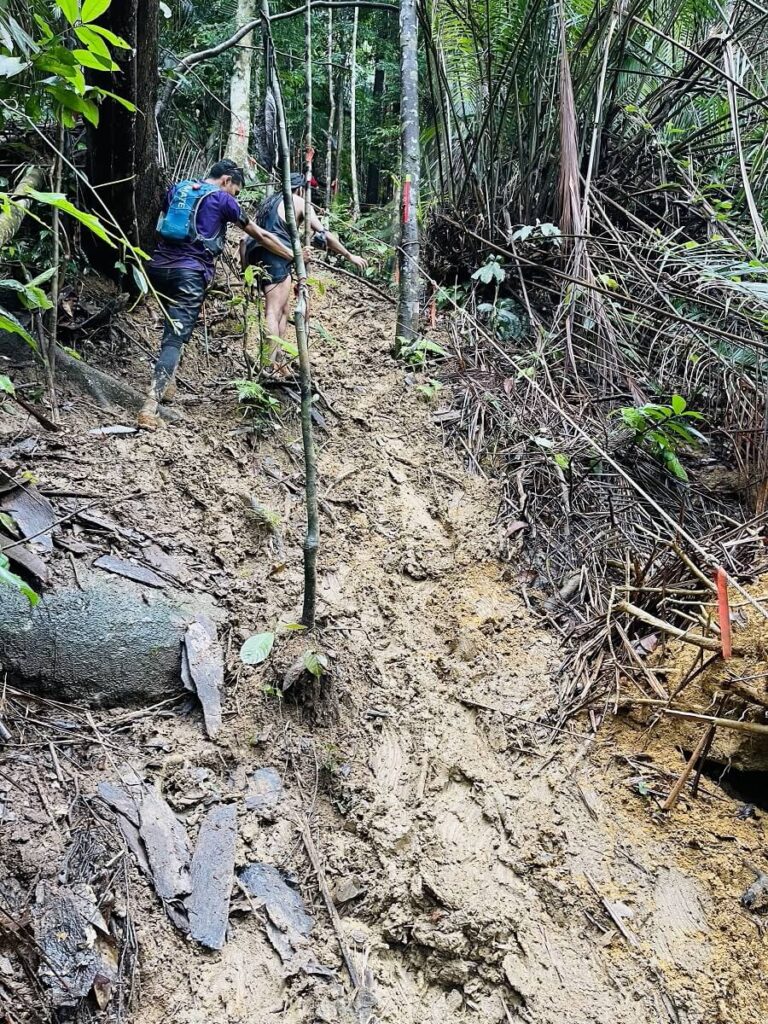
Not even halfway of the course, the base of my left shoe started to detach slightly threating to give way. Having been out there for more than eight hours, I was already quite beaten up climbing and sliding down the slippery muddy trails. With a half-working shoe, I was ready to throw in the towel and call it a day.
At Check Point 4 – 34km into the race, I told my race buddy, who is also my brother, that the race was very tough. It was taking a toll on me. And with my shoe excuse, I was ready to quit and live at peace with the outcome. He was equally tired but was nevertheless in a better condition than me. He asked me in return ‘Were you not expecting to be feeling like this coming into the infamous MMTF 84km race?’
He was right. And he reminded me that I did expect to be feeling what I was experiencing then. It was supposed to be a tough race and it was just panning out exactly how it was expected to be. I have forgotten that mentally I have reminded myself to be prepared to suffer. Once that sank in, I actually felt better and experienced a renewed will to continue.
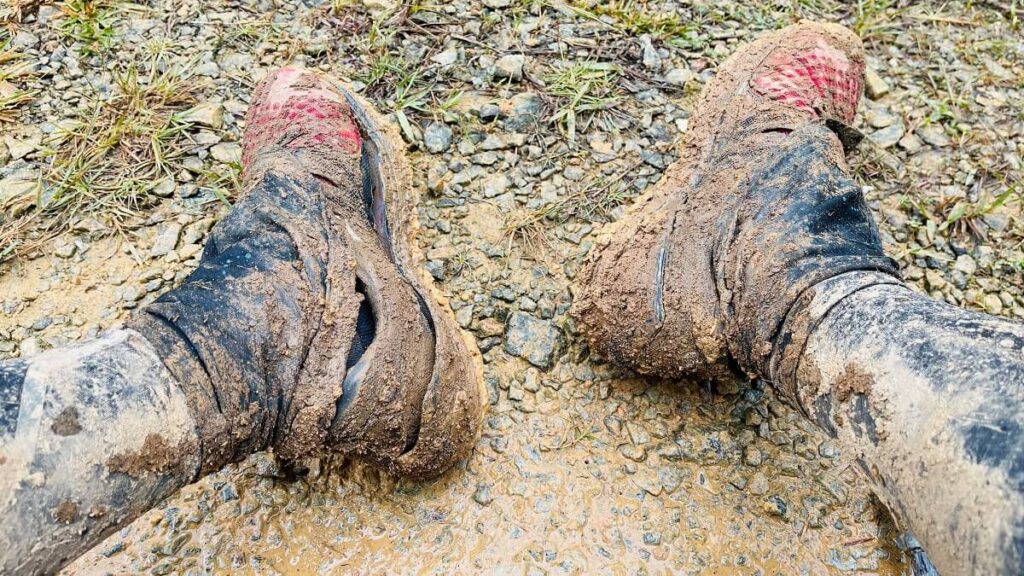
I decided to soldier on and continue my campaign as long as my shoes stay intact. Leaving Check Point 4, we were just about to embark on the toughest section of the race involving two monstrous climbs of about 1,200m and 1,300m each. The worst that could happen I thought, was that my left shoe falls apart and I totter to the next check point and be sent back to the race village in a pickup truck.
After the first big climb and descent to the base of the hill at Check Point 6, we were confronted with the option of calling it a day and walk back to the race village which was only about 2km away. The thought of going back to the comfort of the hotel room to rest and eat was very tempting. By that time, we have covered 54km and been out for more than 14 hours.
The idea of going back into the trail for the second big climb was daunting. A steep 1,300m continuous elevation climb stood between us and the finishing line. I was ready to quit if my brother felt the same. We sat on the road beside the check point, refill our water flasks and contemplated whether to continue. Less than 10 minutes into resting my legs, as I was just finishing my banana, my brother said let’s do it!
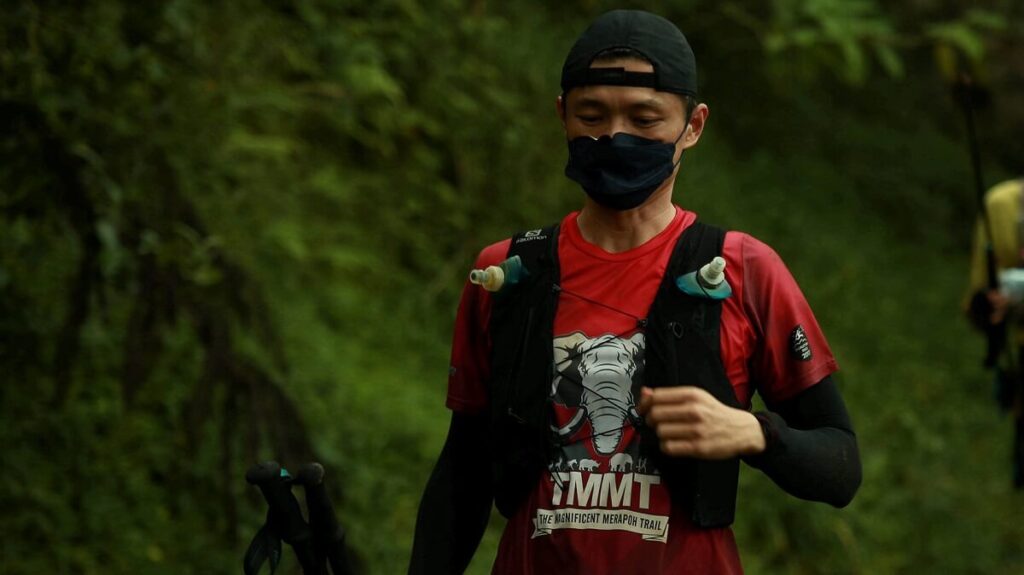
Long story short, my left shoe remained intact and somehow I completed the race. I remembered the two big climbs were tough but somehow I conquered them not too badly. ‘One step at a time and I will surely reach the peak’ became the mantra as I hiked through the night. It took us about another four hours to reach the Maxwell Hill peak for the second time that day via another route.
The saving grace of the brutal 84km trail route is that it takes you down Maxwell Hill via the tarmac service road. So once you clinched the peak, you get to run down the hill. The road down is steep and spans about 12km. To some, that downhill can be also tough as you pound your legs on the hard tarmac continuously. For me, gravity is always a good friend and I was just happy shuffling downhill.
I crossed the finish line at 3:41am the following morning with my brother, after spending a total of 21 hours and 41 minutes to complete the 84km trail course. It was still drizzling when we returned to the race village. Privately I had targeted a sub-20 hour’s finish but considering the never-ending rain, trail conditions and a broken left shoe, I was happy with the result.
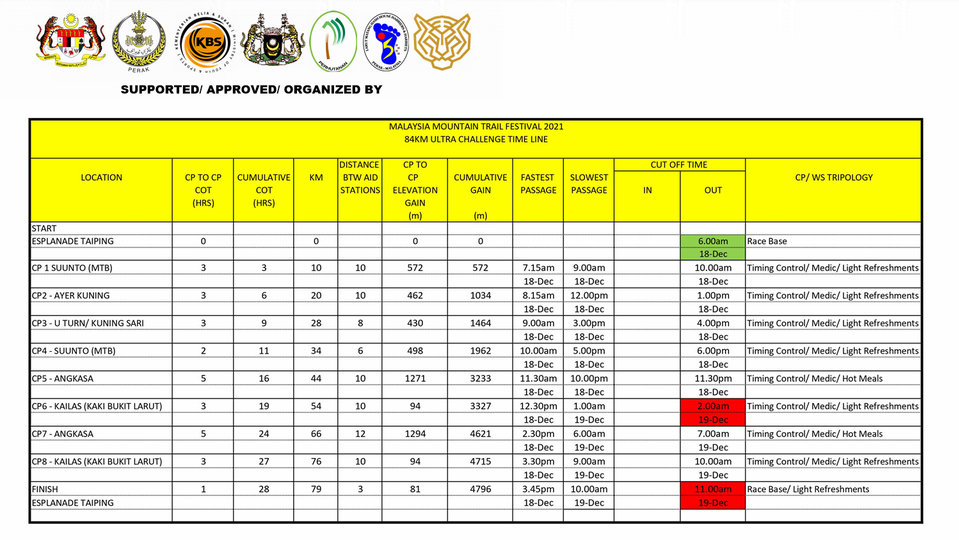
Looking back, there were a few things done right which helped me finish the race.
1. Getting enough sleep
I targeted eight hours (or more) of sleep a week leading to the race weekend. It wasn’t easy because work was demanding during that period. Nevertheless I think I had a minimal of seven hours each day of quality rest. With the accumulated sleep, I was able to race well into the night and not bogged down by sleep deprivation. I was out for close to 22 hours but when I finished, I wasn’t sleepy or tired mentally.
2. Avoiding physical and mental stress
I started tapering my training about three weeks leading to the race. In the last week, I was hardly running much and chose to let my body and legs rest instead. I ran a few easy short distances (less than 5km) and happily enjoyed many days off running. I took leave from work the day before the race and make my way to race location (3 hours journey) with plenty of time to spare for an easy evening before race morning.
3. Training the specifics
MMTF 84km is a trail race with over 4,600m of elevation gain. Therefore it is important to train your legs for the climbs and descents. As far as ten weeks leading to the race, I made sure to incorporate at least a decent trail session with minimum of 1,000m elevation gain each week. It wasn’t really enough, but that was all I could manage with full time work and a family.
4. Racing with a buddy
Everyone’s fitness and pace is different and for a small race over a big distance, the runners would spread out thin and far. Having someone to run or hike along does make the journey lighter and livelier. In my case I had my brother slowing down a notch to wait for me and pull me along throughout the distance. I felt obligated to keep up and not slow him down too much. It was also harder for me to quit halfway since I should also not abandon him to complete the journey alone.
5. Expecting it to be hard
I had approached this race with respect and humility. I understood what the trail expected of me and I was aware of my own ability. I knew the race would be hard for me. Since I had prepared my mind for a tough race, I was able to manage my emotional state better when I suffered through the ordeal. It was brutal but I already knew it would be. It would be very different if the race had caught me unprepared mentally.
Post-race my brother pointed out that our performance for this outing is at around 50th percentile of those who started and completed the race within the cut off time. This is a poorer finishing than our usual 70th percentile placing for the 50 to 55km ultras.
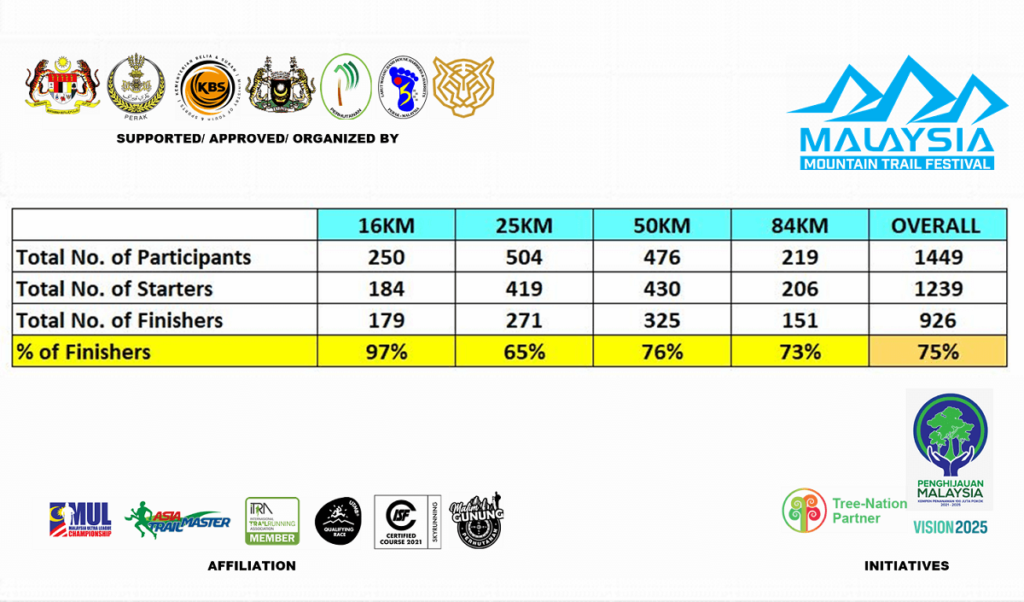
We started out relatively strong but as the race progresses, many other runners hiked past us on the uphill climbs. My weakness has always been on the climbs. The only thing that I could think of on doing better and improving would be putting in more training hours with emphasis on hard uphill intervals as well as big trail climbs at moderate to fast pace.
Like many times before, it is rather comical that I was all ready to give up my quest of running a 100km trail ultra when I was suffering mid race but then just after a few hours of completion, I started thinking of tackling a next harder/longer race. There is definitely a limit to our individual abilities, but what I can say is that our mind and body is tougher that we think.
I was worried that the demand of this race would take a toll on my body and leave muscle aches for days after, as I have experienced before in my earlier ultras. Interestingly, I felt alright other than my legs muscles being a little tight for a few days. All is well and that could only mean two things. It’s either I am now fitter than before, or I had not pushed hard enough for the race.
Anyway, I think showing up at the starting line of the 84km trail ultra did require courage. Courage does not mean that I wasn’t afraid. It means I did not let fear stop or control me. And when I faced fear head-on, I realised that I am more capable than I imagined.
I am glad that I was able to finish what I started. It has built my confidence, resilience and gave me a sense of self-worth. So take courage when you go through challenges in life. Don’t be afraid to face your fears, because on the other side of fear is a world of possibilities.
